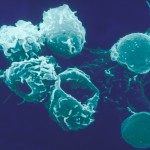Lien vers Pubmed [PMID] – 11207250
J. Immunol. 2001 Mar;166(5):3008-18
The mechanisms by which the immune system achieves constant T cell numbers throughout life, thereby controlling autoaggressive cell expansions, are to date not completely understood. Here, we show that the CD25(+) subpopulation of naturally activated (CD45RB(low)) CD4 T cells, but not CD25(-) CD45RB(low) CD4 T cells, inhibits the accumulation of cotransferred CD45RB(high) CD4 T cells in lymphocyte-deficient mice. However, both CD25(+) and CD25(-) CD45RB(low) CD4 T cell subpopulations contain regulatory cells, since they can prevent naive CD4 T cell-induced wasting disease. In the absence of a correlation between disease and the number of recovered CD4(+) cells, we conclude that expansion control and disease prevention are largely independent processes. CD25(+) CD45RB(low) CD4 T cells from IL-10-deficient mice do not protect from disease. They accumulate to a higher cell number and cannot prevent the expansion of CD45RB(high) CD4 T cells upon transfer compared with their wild-type counterparts. Although CD25(+) CD45RB(low) CD4 T cells are capable of expanding when transferred in vivo, they reach a homeostatic equilibrium at lower cell numbers than CD25(-) CD45RB(low) or CD45RB(high) CD4 T cells. We conclude that CD25(+) CD45RB(low) CD4 T cells from nonmanipulated mice control the number of peripheral CD4 T cells through a mechanism involving the production of IL-10 by regulatory T cells.



